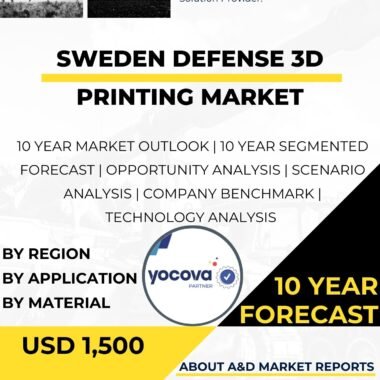Description
The Netherlands Defense 3D printing market has experienced remarkable growth and transformation, driven by the country’s commitment to leveraging additive manufacturing technologies for defense applications. 3D printing, also known as additive manufacturing, is a revolutionary manufacturing process that builds three-dimensional objects layer by layer from digital designs. This innovative technology has the potential to revolutionize the defense industry by offering increased flexibility, reduced production time, cost-effectiveness, and the ability to create complex and customized components.
The Dutch defense sector has been quick to recognize the advantages of 3D printing and has actively invested in research, development, and integration of this technology into its operations. The Netherlands aims to harness the full potential of 3D printing to enhance its military capabilities, improve logistics, reduce supply chain dependencies, and address the challenges posed by obsolete and hard-to-source spare parts for legacy systems.
One of the key applications of 3D printing in the Netherlands Defense market is in the rapid prototyping and design validation of new defense systems and equipment. With 3D printing, defense researchers and engineers can quickly create physical prototypes of military hardware, such as weapon components, protective gear, and unmanned systems, allowing for iterative design improvements and reducing time-to-market.
Furthermore, the on-demand and decentralized manufacturing capabilities of 3D printing offer a strategic advantage for the Dutch Armed Forces. Forward-deployed units can manufacture spare parts, tools, and mission-specific equipment locally, eliminating the need for lengthy and costly supply chains. This capability enhances the self-sufficiency of military operations and ensures that critical components are readily available, even in remote or challenging environments.
The Netherlands Defense 3D printing market has also shown great promise in the repair and maintenance of military assets. With many defense systems aging or becoming obsolete, finding replacement parts can be a significant challenge. 3D printing enables the reproduction of legacy components that may no longer be in production or easily sourced, thereby extending the operational life of vital equipment.
In addition to traditional military applications, the Netherlands has embraced 3D printing for soldier modernization efforts. Customized protective gear, such as helmets and body armor, can be 3D printed to provide a better fit and enhanced comfort for individual soldiers. This personalization ensures that soldiers can operate more effectively in the field, leading to improved readiness and mission success.
Collaboration with academia and the private sector has been instrumental in advancing the Netherlands Defense 3D printing market. The Dutch government has fostered partnerships with universities, research institutions, and industry experts to develop cutting-edge 3D printing technologies and processes. Collaborative efforts have resulted in the optimization of materials, improvement of printing techniques, and the exploration of new applications for defense-specific requirements.
The Netherlands’ dedication to responsible and ethical 3D printing practices is evident in its adherence to strict quality control and safety standards. The certification and validation of 3D printed components for use in critical defense systems are paramount to maintaining operational reliability and safety. The Dutch defense industry continually seeks to enhance quality assurance processes and ensure that 3D printed components meet or exceed the performance requirements of traditional manufacturing methods.
The export potential of the Netherlands Defense 3D printing market is significant. The country’s reputation for technological innovation and quality assurance has attracted interest from other nations seeking to modernize their defense capabilities. Exporting 3D printing technologies and expertise not only supports the Dutch defense industry but also fosters international collaboration and strengthens defense ties with partner countries.
Moreover, the Netherlands Defense 3D printing market extends beyond military applications. Dual-use technologies and advancements in 3D printing materials have generated interest in civilian sectors as well. The country’s expertise in 3D printing for defense can be leveraged in industries such as aerospace, automotive, healthcare, and consumer goods.
Despite the numerous benefits of 3D printing, the Netherlands Defense market faces challenges that require careful consideration. Cybersecurity is a critical concern, as 3D printing files and data can be vulnerable to theft or manipulation. Ensuring the integrity of design files and safeguarding intellectual property is essential to maintain the security of defense systems and equipment.
Standardization and certification processes are also crucial to ensure the reliability and interoperability of 3D printed components. The Netherlands has been actively working with international organizations and partners to establish industry standards for additive manufacturing in the defense sector, promoting interoperability and enabling multinational collaboration.
In conclusion, the Netherlands Defense 3D printing market has witnessed impressive growth and development, driven by the country’s dedication to advancing its military capabilities through innovative manufacturing technologies. 3D printing offers the Dutch Armed Forces greater flexibility, reduced logistics burdens, and improved maintenance capabilities, enabling them to respond effectively to evolving defense challenges. Collaborations with academia and the private sector have played a crucial role in advancing 3D printing technologies for defense applications, ensuring that the Netherlands remains at the forefront of additive manufacturing in the global defense industry. With its commitment to responsible and ethical practices, the Netherlands Defense 3D printing market holds enormous potential not only in the military domain but also in civilian sectors, fostering economic growth and international cooperation. As the technology continues to mature, the Netherlands is well-positioned to maximize the benefits of 3D printing, ensuring that its defense capabilities remain agile, innovative, and prepared for the challenges of the future.




